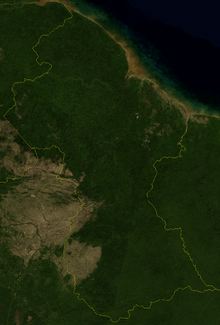Pork-knocker
Pork-knockers are freelance Guyanese prospectors who mine for diamonds and gold in the alluvial plains of the Guyanese interior. The name "pork-knockers" refers to their regular diet of pickled pork of wild pig that is often eaten at the end of the day.[1] Caribbean author A. R. F. Webber suggested that the term may have originated as "pork-barrel knocker".[2]

A 1921 account observed that most pork-knockers of that era were of African descent and worked individually or in small groups.[3] Pork-knockers have often been dependent on bush traders, who carry mining supplies and sometimes grubstake the pork-knockers' operations.[4][3] Pork-knockers may work in close proximity to each other and disputed claims may lead to violence.[5]
Pork-knockers have been responsible for discovering large deposits of gold and diamonds. Many Guyanese stories describe pork-knockers who have made fortunes only to lose them in a tragic or comic fashion.[6] Guyana-born author Jan Carew's 1958 novel Black Midas involves a boy leaving his coastal village to become a pork-knocker.[7]
The presence of pork-knockers in the Guyanese interior has upset traditional Amerindian life there. The Akawaio people have experienced land disputes with pork-knockers and have been adversely affected by a rising cost of living. Amazonian anthropologist Audrey Butt Colson observed that mining has led to a collapse of the subsistence economy. Butt Colson writes that mining village Kamarang, known as "Red Light City", typifies the "pork-knocker syndrome of drink, gambling, sex, conspicuous consumption and, from time to time, violence."[8]
See also
References
- ↑ "Pork-knocker". Dictionary of Caribbean English usage. Kingston, Jamaica [u.a.]: Univ. of the West Indies Press. 2003. p. 450. ISBN 9789766401450.
- ↑ Menezes, Mary Noel, ed. (1979). The Amerindians in Guyana, 1803-73: A Documentary History. London: Cass. p. 300. ISBN 978-0-7146-4030-3.
- 1 2 "Diamond Production Makes Great Increase". Engineering and Mining Journal. 111 (8): 363. February 19, 1921.
- ↑ The Journal of Gemmology. Gemmological Association of Great Britain. 17: 477. 1980. Missing or empty
|title=(help) - ↑ "Mining Reporter: Life on the Cayenne Gold Fields". Mining American. 49: 86. January 28, 1904.
- ↑ "Searching for Diamonds". World Digital Library. Retrieved 2 August 2013.
- ↑ Lewis, Gordon K. (2004). The Growth of the Modern West Indies. Kingston, Jamaica: I. Randle. p. 292. ISBN 9789766371715.
- ↑ "Maps, Power, and the Defense of Territory". Communities and Conservation: Histories and Politics of Community-based Natural Resource Management. Walnut Creek, Calif.: AltaMira Press. 2005. p. 289. ISBN 978-0-7591-0506-5.